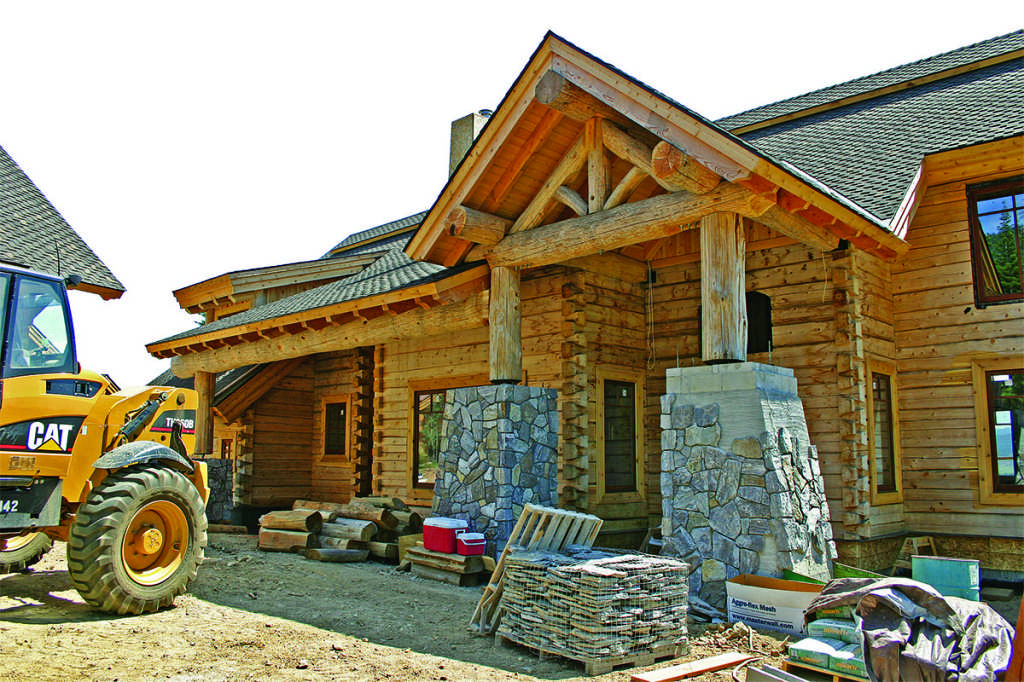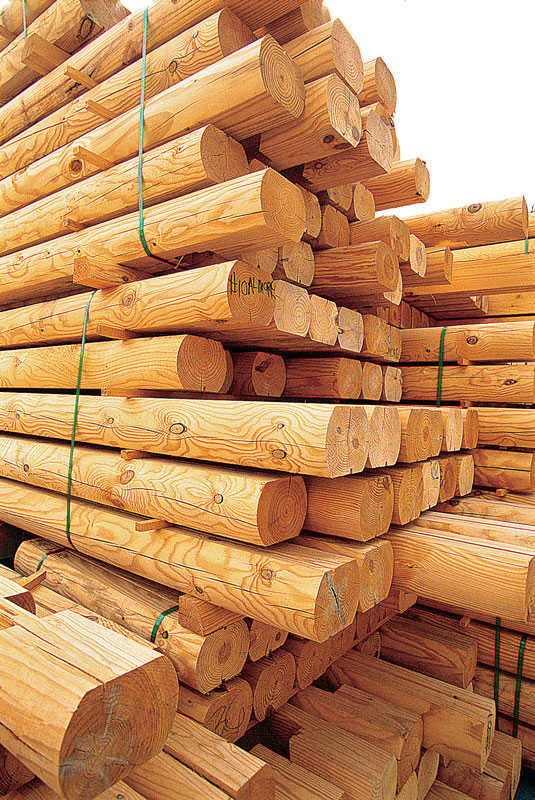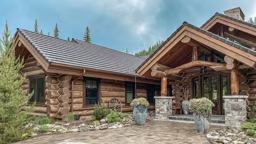8 steps to a quickly built log home.
By Charles Bevier

We want it all—fast. In a world where online shopping, instant messaging and cell phones are all the rage because of quickness and convenience, it's not surprising that some consumers want the same thing when it comes to building a log home. Rather than endure a long planning process and construction schedule, many folks want to fast track their project and move into a new home in a matter of months. We've compiled eight suggestions from the pros to help you make it happen in less than six months—and save money.
Step 1: Find Financing
Choose a log-friendly mortgage company that specializes in construction-permanent loans. Then, get pre-approved for a specific amount before you go shopping for designs or a log producer. "We've had clients get in and out of the process in a month," says Tracy Keyser with the System Built division of M&T Mortgage, which offers special loan programs for log home buyers. Even though you plan to fast track this project, give yourself ample time on your construction-loan schedule, Keyser advises; otherwise, you'll pay more in penalties if you go over the allotted time. (You should note that construction loans run from three to 18 months.)
Step 2: Pick a Site
Start working with local real estate agents or developers. To get into your new home by winter, you'll need to make a quick decision on a lot or parcel. If you already own land, make sure the lot is suitable for building- especially when it comes to slope, soil conditions, accessibility, zoning and use of surrounding properties. Contact soil engineers in your area and get them cracking on an analysis. Subsurface concerns include the availability, quality and drilling depth you'll need to obtain well water, as well as your building site's ability to pass a percolation or "perc" test. This test is used to determine whether the land will readily accept wastewater from a septic system.
Step 3: Create a Schedule
Create a realistic pre-construction schedule and stick to it. "My strongest recommendation is to develop a plan and then work within the plan," says Tim Casey with Town & Country Cedar Homes in Petoskey, Michigan. If you change one aspect of your plan, be aware that you invite a cascading effect of delays that could wreak havoc on your schedule.
 Step 4: Decide on a Design
Step 4: Decide on a Design
You can save valuable time by using an existing plan from a producer's catalog of designs. "You avoid the additional time it takes for custom design and engineering, as well as the approval process needed with your local building department or your state," says Maggie Caruso of Modern Homes of Muskegon, Illinois. Jeff Arnold, with Heritage Log Homes, agrees. "All of the engineering is done on existing plans. You can easily save 30 days on your schedule by using one of these."
Step 5: Pick a Producer
Although you should pick a producer as quickly as possible, it's a good idea to have at least three companies offer competitive bids on your design before deciding. Share your budget with them and your desire to fast track your project. "Be blunt," says Jeff. "Tell them, 'I want this done fast, and I'm prepared to do anything.' " Some companies specialize in fast tracking projects, even if you want a custom design. Tom Riess with Southland Log Homes says his company can go from a customer's hand-drawn sketch to a precut log home package in 35 days, provided the client secures a delivery date for that package. "There are certain months that sell out of delivery dates quickly," says Tom, "but we can usually get a custom design done in that time frame. But the customer needs to get his or her sketch right the first time and avoid changes." Most companies require a down payment to create construction drawings (10 percent of the log home's estimated package price); other companies require another deposit before cutting logs (40 percent in some cases) and the balance upon delivery. You can hurry this process by giving the producer as much as 50 percent of the cost up front, which can often move your project to the head of the production schedule. "If you go with 50 percent up front, try to negotiate a discount of 3 to 5 percent off the cost of the package," says Jeff.
Step 6: Choose a Builder
"The manufacturer may have some suggestions on a builder to use," says Jeff. The choice you make impacts the allocation of responsibilities and, perhaps most important, affects financing and your budget. Because labor might account for 30 to 40 percent of the total cost of a log home, you can save a portion of this by performing some of the work yourself. You have three options: professionally built, owner-contractor or owner-builder (do-it-yourselfer). To fast track your log home, the last option isn't recommended. Having a pro build your home is the easiest and fastest option, since he will have the expertise, the contacts in the building community and the tools and equipment to avoid challenges that often confound novices. Even if you're serving as the general contractor on your project, you still can fast track it if you stay organized and stick to your plan. Tom of Southland Log Homes has a recent success story: An investment banker with no carpentry experience constructed the shell of a Southland-produced home in two weeks (OK, he had a little help from friends and family). The customer, serving as an owner-contractor, finished the home in less than six months.
Step 7: Consider More Complete Systems
While all log homes originate in a logyard or a manufacturing facility, some companies have taken this process a step further by constructing the majority of the home in a factory. These homes arrive at your building site as a series of panels or modules and are set by crane on a permanent foundation for finishing. Since factory-based construction and site preparation (installation of foundation, water, septic) take place simultaneously, homes are finished and ready for occupancy faster. These new options aren't limited to above-ground construction. Foundations, for example, can arrive at your job site as a series of pre-cast concrete or pressure-treated wood panels. These are set by crane in a day, and they often provide better thermal performance than poured concrete or block foundations.
Step 8: Avoid Delays
Log homes aren't immune to factors that can delay any project. Bad weather can certainly slow construction, as can a lack of talented labor—particularly during the peak of a building season. Make sure these factors don't delay your project by having contingency plans in place. Another sure way to create a delay is to deviate from your blueprints. Your lender bases his loan on your plans, and regular inspections are scheduled to see if you're complying. If you alter your plan or make last-minute design changes, your project will have to go through the loan application and approval process yet again. If possible, pick an appraiser who understands the value of log homes. You certainly don't want someone to undervalue your dream house, which can delay construction or mean that you have to come up with more cash. Are these eight steps critical? You bet. But they're also manageable, especially if you're diligent, proactive and able to keep an eye on potential problem areas. So, set aside a little money for invitations—you could be hosting a feast with family and friends in your new home in no time.
 We want it all—fast. In a world where online shopping, instant messaging and cell phones are all the rage because of quickness and convenience, it's not surprising that some consumers want the same thing when it comes to building a log home. Rather than endure a long planning process and construction schedule, many folks want to fast track their project and move into a new home in a matter of months. We've compiled eight suggestions from the pros to help you make it happen in less than six months—and save money.
We want it all—fast. In a world where online shopping, instant messaging and cell phones are all the rage because of quickness and convenience, it's not surprising that some consumers want the same thing when it comes to building a log home. Rather than endure a long planning process and construction schedule, many folks want to fast track their project and move into a new home in a matter of months. We've compiled eight suggestions from the pros to help you make it happen in less than six months—and save money.









_11868_2024-09-17_08-44-256x288.avif)


